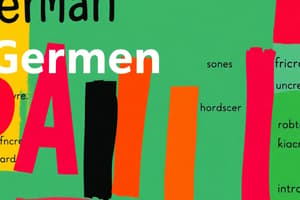Podcast
Questions and Answers
What is the primary language in Germany?
What is the primary language in Germany?
- Italian
- French
- Spanish
- German (correct)
How many grammatical cases are there in German?
How many grammatical cases are there in German?
- Two
- Three
- Five
- Four (correct)
Which of the following is a notable feature of German nouns?
Which of the following is a notable feature of German nouns?
- Nouns have three genders (correct)
- All nouns are neutral
- Nouns are always lowercase
- Nouns have no grammatical gender
In which aspect does German grammar typically differ from English?
In which aspect does German grammar typically differ from English?
What is an umlaut in the context of the German language?
What is an umlaut in the context of the German language?
Which of the following is a suggestion for learning German effectively?
Which of the following is a suggestion for learning German effectively?
What is the impact of dialects in the German language?
What is the impact of dialects in the German language?
Which of the following best describes the word formation in German?
Which of the following best describes the word formation in German?
Flashcards are hidden until you start studying
Study Notes
Overview of the German Language
- Language Family: Germanic branch of the Indo-European family.
- Official Language: Primary language in Germany, Austria, Switzerland, and parts of Italy and Belgium.
- Speakers: Approximately 90 million native speakers.
Dialects
- Varieties: Standard German (Hochdeutsch) and numerous regional dialects (e.g., Bavarian, Swabian, Low German).
- Influence: Dialects can vary significantly in pronunciation, vocabulary, and grammar.
Grammar
- Nouns: Three genders (masculine, feminine, neuter) with specific articles (der, die, das).
- Cases: Four grammatical cases – nominative, accusative, dative, genitive.
- Verbs: Regular and irregular verbs; separation of prefixes is common in sentence structure.
- Word Order: In main clauses, the verb typically comes second; in subordinate clauses, it goes to the end.
Vocabulary
- Root Words: Many German words are compound words, combining smaller parts to create new meanings.
- Loanwords: English has borrowed many German words; similarly, German includes loanwords from English and other languages, especially in technology and culture.
Pronunciation
- Vowels and Consonants: Distinct sounds; includes umlauts (ä, ö, ü) affecting pronunciation.
- Stress Patterns: Generally, the first syllable of a word is stressed, with exceptions.
Writing System
- Alphabet: 26 letters, with additional characters (ä, ö, ü, ß).
- Capitalization: Nouns are always capitalized.
- Punctuation: Standard punctuation similar to English, with specific rules for quotation marks and commas.
Cultural Context
- Influence: German culture has a rich history in literature, philosophy, music, and art (e.g., Goethe, Kant, Beethoven).
- Modern Usage: The German language is prominent in scientific, philosophical, and business contexts within Europe.
Learning Tips
- Practice Listening: Engage with German media (films, music, podcasts) for better comprehension and pronunciation.
- Speak Regularly: Use language exchange platforms or local conversation groups to practice speaking.
- Immerse Yourself: Consider studying abroad or participating in a cultural exchange program for full immersion.
Language Family and Stats
- German is part of the Germanic branch of the Indo-European language family.
- It is the primary language in Germany, Austria, Switzerland, and parts of Italy and Belgium.
- Approximately 90 million people speak German as their native language.
Dialects and Variations
- Standard German (Hochdeutsch) is the official form of the language, but numerous regional dialects exist.
- Some examples of dialects include Bavarian, Swabian, and Low German.
- Dialects heavily influence pronunciation, vocabulary, and grammar.
Grammar Basics
- German nouns have three genders: masculine, feminine, and neuter.
- Each gender has a specific article: "der" (masculine), "die" (feminine), and "das" (neuter).
- There are four grammatical cases in German: nominative, accusative, dative, and genitive.
- Verbs can be regular or irregular.
- One common feature of German sentence structure is the separation of prefixes in verbs.
- In main clauses, the verb typically comes second, while in subordinate clauses, it goes to the end.
Vocabulary Insights
- German frequently employs compound words, combining smaller parts to create new meanings.
- English has borrowed numerous words from German.
- German also includes loanwords from English and other languages, particularly in technology and culture.
Pronunciation and Sounds
- German features distinct vowel and consonant sounds.
- Umlauts (ä, ö, ü) affect pronunciation.
- Generally, the first syllable of a word is stressed.
Writing System and Punctuation
- The German alphabet has 26 letters, with additional characters like ä, ö, ü, and ß.
- All German nouns are capitalized.
- Punctuation rules are largely similar to English, with specific conventions for quotation marks and commas.
Cultural Context and Influence
- German culture boasts a rich history in literature, philosophy, music, and art.
- Renowned figures like Goethe, Kant, and Beethoven contributed significantly.
- German continues to play a prominent role in scientific, philosophical, and business contexts across Europe.
Learning Tips
- Regularly engage with German media like films, music, and podcasts to improve comprehension and pronunciation.
- Utilize platforms or groups for language exchanges to practice speaking.
- Consider studying abroad or participating in a cultural exchange program for complete immersion in the language.
Studying That Suits You
Use AI to generate personalized quizzes and flashcards to suit your learning preferences.





